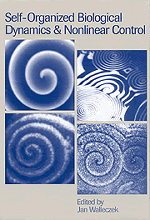 Self-Organized Biological Dynamics and Nonlinear Control
Self-Organized Biological Dynamics and Nonlinear Control Book contents
- Frontmatter
- Contents
- List of contributors
- Preface
- The frontiers and challenges of biodynamics research
- Part I Nonlinear dynamics in biology and response to stimuli
- 1 External signals and internal oscillation dynamics: principal aspects and response of stimulated rhythmic processes
- 2 Nonlinear dynamics in biochemical and biophysical systems: from enzyme kinetics to epilepsy
- 3 Fractal mechanisms in neuronal control: human heartbeat and gait dynamics in health and disease
- 4 Self-organizing dynamics in human sensorimotor coordination and perception
- 5 Signal processing by biochemical reaction networks
- Part II Nonlinear sensitivity of biological systems to electromagnetic stimuli
- Part III Stochastic noise-induced dynamics and transport in biological systems
- Part IV Nonlinear control of biological and other excitable systems
- Index
1 - External signals and internal oscillation dynamics: principal aspects and response of stimulated rhythmic processes
Published online by Cambridge University Press: 14 August 2009
- Frontmatter
- Contents
- List of contributors
- Preface
- The frontiers and challenges of biodynamics research
- Part I Nonlinear dynamics in biology and response to stimuli
- 1 External signals and internal oscillation dynamics: principal aspects and response of stimulated rhythmic processes
- 2 Nonlinear dynamics in biochemical and biophysical systems: from enzyme kinetics to epilepsy
- 3 Fractal mechanisms in neuronal control: human heartbeat and gait dynamics in health and disease
- 4 Self-organizing dynamics in human sensorimotor coordination and perception
- 5 Signal processing by biochemical reaction networks
- Part II Nonlinear sensitivity of biological systems to electromagnetic stimuli
- Part III Stochastic noise-induced dynamics and transport in biological systems
- Part IV Nonlinear control of biological and other excitable systems
- Index
Summary
Introduction
The description of order and function in biological systems has been a challenge to scientists for many decades. The overwhelming majority of biological order is functional order, often representing self-organized dynamical states in living matter. These states include spatial, temporal and spatiotemporal structures, and all of them are ubiquitous in living as well in nonliving matter. Prominent examples are patterns (representing static functions), oscillatory states (rhythmic processes), travelling and spiraling waves (nonlinear phenomena evolving in space and time).
From a fundamental point of view, biological function must be treated in terms of dynamic properties. Biological systems exhibit a relative stability for some modes of behavior. In the living state, these modes remain very far from thermal equilibrium, and their stabilization is achieved by nonlinear interactions between the relevant biological subunits. The functional complexity of biological materials requires the application of macroscopic concepts and theories, the consideration of the motion of individual particles (e.g., atoms, ions, molecules) is either meaningless or not applicable in most cases.
The existence and stabilization of far-from-equilibrium states by nonlinear interactions within at least some subunits of a physical, chemical or biological system are intimately linked with cooperative processes. Besides the well- known strong equilibrium cooperativity, thermodynamically metastable states and nonequilibrium transitions in cooperatively stabilized systems can occur, provided a certain energy input is present.
- Type
- Chapter
- Information
- Self-Organized Biological Dynamics and Nonlinear ControlToward Understanding Complexity, Chaos and Emergent Function in Living Systems, pp. 15 - 43Publisher: Cambridge University PressPrint publication year: 2000
- 4
- Cited by


